PDF chapter test TRY NOW
For the metabolic activity of leeches, oxygen is respired, and the circulatory system helps to carry the oxygen throughout the body. For the control and coordination of leech, the nervous system is facilitated.
General terms:
| Haemocoelic fluid |
|
| Diffusion |
|
| Ganglia (plural) |
|
| Nephridia |
|
2. Respiratory system:
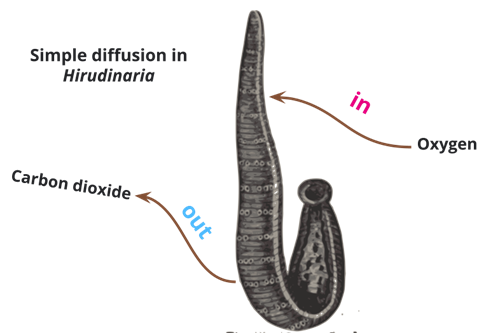
Simple diffusion in leech
Respiration takes place through the skin in the leech, and it is known as cutaneous respiration.
The dense network of tiny blood vessels called capillaries containing the haemocoelic fluid extends between the epidermis cells. The exchange of respiratory gases takes place by diffusion. Oxygen dissolved in waterdiffuses into haemocoelic fluid through the skin, whereas carbon dioxide diffuses out. Mucus secretion keeps the skin moist and slimy, as well as preventing it from drying out.
Important!
Note: Leeches do not have definite respiratory system, since it has no specific respiratory organs.
3. Circulatory system:
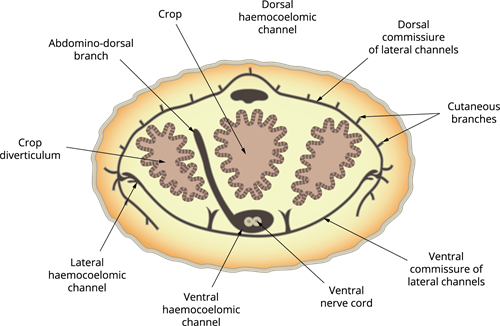
Hirudinaria. T.S body through dorsal and ventral commissures of the lateral haemocoelomic channels
The haemocoelic system is responsible for the circulation in leeches. True blood vessels do not exist. Haemocoelic channels or canals, which are filled with blood-like fluid, replace the blood vessels.
Haemoglobin is present in the coelomic fluid.

A: Diagrammatic representation of the haemocoelomic system of two segments
B: Diagrammatic representation of the lateral channels and their branches
In the above picture, we can see that four longitudinal channels exist in the circulatory system of leech. One channel is located above (dorsal), and one is located below (ventral) the alimentary canal.
- The other two channels, which serve as a heart and have inner valves, are located on the alimentary canal's (lateral) side.
- In the \(26\)th segment, all four channels are joined together posteriorly.
This union of all channels can be seen in the below picture.
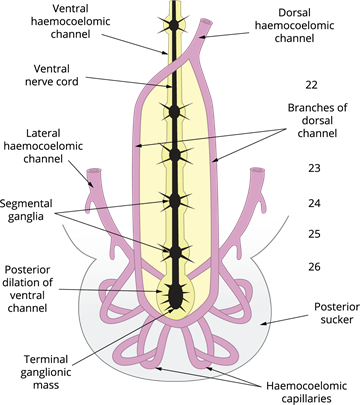
Hind end of the body showing union of the four longitudinal haemocoelomic channels
4. Nervous system:
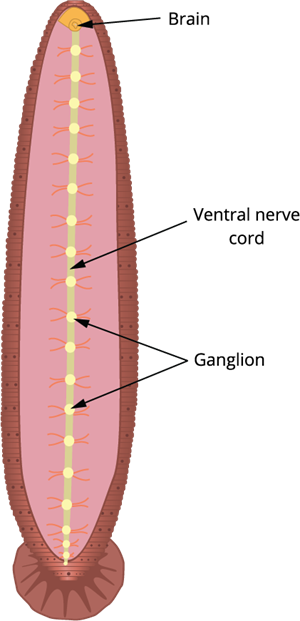
Nervous system of leech
As shown in the above picture, a nerve ring and a paired ventral nerve cord make up the central nervous system of the leech.
- Suprapharyngeal ganglion (brain), circumpharyngeal connective, and subpharyngeal ganglion make up the nerve ring that surrounds the pharynx.
- The subpharyngeal ganglion is created by the merging of four pairs of ganglia beneath the pharynx.
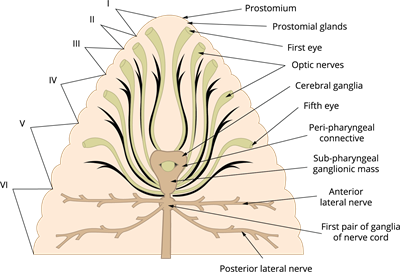
Nervous system in the first six segments
5. Excretory system:
The video explaining the excretory system of leech
Excretion is carried out by nephridia, which are segmentally arranged paired tubules in the leech. From the \(6\)th to the \(22\)nd segments, there are \(17\)pairs of nephridia that open out through nephridiopores.
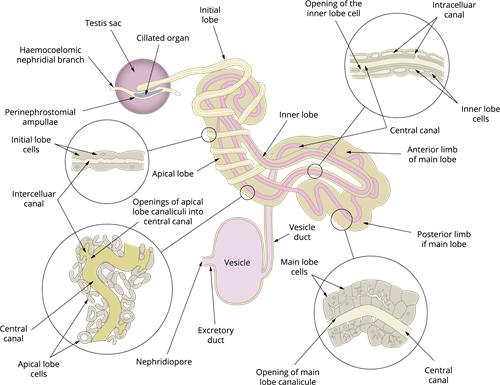
Excretory system of leech
A. A complete testicular nephridium
B. A portion of initial lobe in longitudinal section
C. A portion of inner lobe in longitudinal section
D. A portion of apical lobe in longitudinal section
E. A portion of main lobe in longitudinal section
Reference:
https://www.maxpixel.net/Blood-letting-Healing-Medical-Leech-Blood-Wounds-2025081
https://upload.wikimedia.org/wikipedia/commons/b/be/Simple_Diffusion.png
